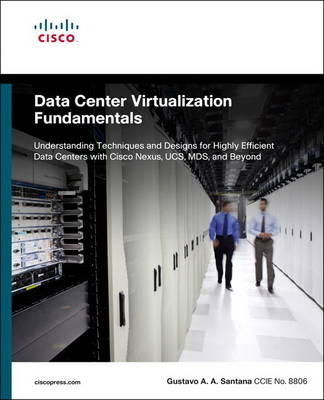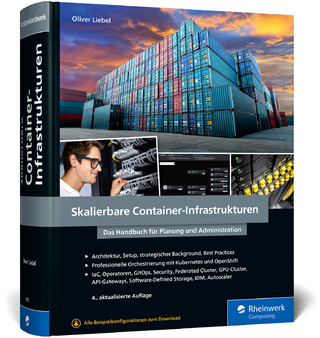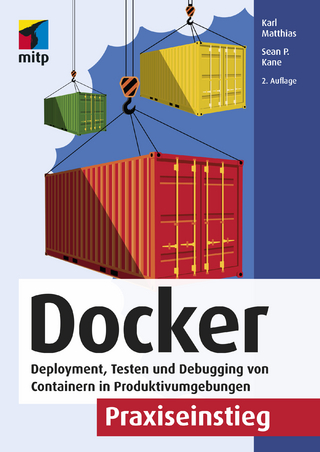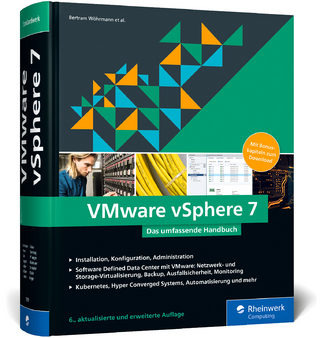
Data Center Virtualization Fundamentals
Cisco Press (Verlag)
978-1-58714-324-3 (ISBN)
- Titel ist leider vergriffen;
keine Neuauflage - Artikel merken
For many IT organizations, today’s greatest challenge is to drive more value, efficiency, and utilization from data centers. Virtualization is the best way to meet this challenge. Data Center Virtualization Fundamentals brings together the comprehensive knowledge Cisco professionals need to apply virtualization throughout their data center environments. Leading data center expert Gustavo A. A. Santana thoroughly explores all components of an end-to-end data center virtualization solution, including networking, storage, servers, operating systems, application optimization, and security. Rather than focusing on a single product or technology, he explores product capabilities as interoperable design tools that can be combined and integrated with other solutions, including VMware vSphere. With the author’s guidance, you’ll learn how to define and implement highly-efficient architectures for new, expanded, or retrofit data center projects. By doing so, you can deliver agile application provisioning without purchasing unnecessary infrastructure, and establish a strong foundation for new cloud computing and IT-as-a-service initiatives. Throughout, Santana illuminates key theoretical concepts through realistic use cases, real-world designs, illustrative configuration examples, and verification outputs. Appendixes provide valuable reference information, including relevant Cisco data center products and CLI principles for IOS and NX-OS. With this approach, Data Center Virtualization Fundamentals will be an indispensable resource for anyone preparing for the CCNA Data Center, CCNP Data Center, or CCIE Data Center
certification exams.
Gustavo A. A. Santana, CCIE® No. 8806, is a Cisco Technical Solutions Architect working in enterprise and service provider data center projects that require deep integration across technology areas such as networking, application optimization, storage, and servers. He has more than 15 years of data center experience, and has led and coordinated a team of specialized Cisco engineers in Brazil. He holds two CCIE certifications (Routing & Switching and Storage Networking), and is a VMware Certified Professional (VCP) and SNIA Certified Storage Networking Expert (SCSN-E).
Learn how virtualization can transform and improve traditional data center network topologies
Understand the key characteristics and value of each data center virtualization technology
Walk through key decisions, and transform choices into architecture
Smoothly migrate existing data centers toward greater virtualization
Burst silos that have traditionally made data centers inefficient
Master foundational technologies such as VLANs, VRF, and virtual contexts
Use virtual PortChannel and FabricPath to overcome the limits of STP
Optimize cabling and network management with fabric extender (FEX) virtualized chassis
Extend Layer 2 domains to distant data center sites using MPLS and Overlay Transport Virtualization (OTV)
Use VSANs to overcome Fibre Channel fabric challenges
Improve SAN data protection, environment isolation, and scalability
Consolidate I/O through Data Center Bridging and FCoE
Use virtualization to radically simplify server environments
Create server profiles that streamline “bare metal” server provisioning
“Transcend the rack” through virtualized networking based on Nexus 1000V and VM-FEX
Leverage opportunities to deploy virtual network services more efficiently
Evolve data center virtualization toward full-fledged private clouds
-Reviews -
“The variety of material that Gustavo covers in this work would appeal to anyone responsible for Data Centers today. His grasp of virtualization technologies and ability to relate it in both technical and non-technical terms makes for compelling reading. This is not your ordinary tech manual. Through use of relatable visual cues, Gustavo provides information that is easily recalled on the subject of virtualization, reaching across Subject Matter Expertise domains. Whether you consider yourself well-versed or a novice on the topic, working in large or small environments, this work will provide a clear understanding of the diverse subject of virtualization.”
-- Bill Dufresne, CCIE 4375, Distinguished Systems Engineer, Cisco (Americas)
“..this book is an essential reference and will be valuable asset for potential candi¿dates pursuing their Cisco Data Center certifications. I am confident that in reading this book, individuals will inevitably gain extensive knowledge and hands-on experience dur¿ing their certification preparations. If you’re looking for a truly comprehensive guide to virtualization, this is the one!”
-- Yusuf Bhaiji, Senior Manager, Expert Certifications (CCIE, CCDE, CCAr),
Learning@Cisco
“When one first looks at those classic Cisco Data Center blueprints, it is very common to become distracted with the overwhelming number of pieces and linkages. By creating a solid theoretical foundation and providing rich sets of companion examples to illustrate each concept, Gustavo’s book brings hope back to IT Professionals from different areas of expertise. Apparently complex topics are demystified and the insertion of products, mechanisms, protocols and technologies in the overall Data Center Architecture is clearly explained, thus enabling you to achieve robust designs and successful deployments. A must read... Definitely!”
-- Alexandre M. S. P. Moraes, Consulting Systems Engineer – Author of “Cisco Firewalls”
Gustavo A. A. Santana, CCIE No. 8806, is a Cisco Technical Solutions Architect working in enterprise and service provider data center projects that require a greater integration among multiple technology areas such as networking, application optimization, storage, and servers. With more than 17 years of experience in the data center industry, Gustavo leads and coordinates a team of specialized Cisco engineers in Brazil. A true believer of education as a technology catalyst, he has also dedicated himself to the technical development of many IT professionals from customer, partner, and strategic alliance organizations. In addition to holding three CCIE certifications (Data Center, Storage Networking, and Routing & Switching), Gustavo is also an SNIA Certified Storage Networking Expert (SCSN-E). A frequent speaker at Cisco and data center industry events, he holds a degree in computer engineering from Instituto Tecnológico de Aeronáutica (ITA-Brazil) and an MBA in strategic IT management from Fundação Getúlio Vargas (FGV-Brazil).
Foreword xxiii
Introduction xxv
Part I What Is Virtualization?
Chapter 1 Virtualization History and Definitions 1
Data Center Essential Definitions 2
Data Center Evolution 3
Operational Areas and Data Center Architecture 5
The Origins of Data Center Virtualization 8
Virtual Memory 8
Mainframe Virtualization 10
Hot Standby Router Protocol 11
Defining Virtualization 12
Data Center Virtualization Timeline 12
Classifying Virtualization Technologies 14
A Virtualization Taxonomy 15
Virtualization Scalability 17
Technology Areas 18
Classification Examples 21
Summary 22
Further Reading 22
Part II Virtualization in Network Technologies
Chapter 2 Data Center Network Evolution 25
Ethernet Protocol: Then and Now 26
Ethernet Media 27
Coaxial Cable 27
Twisted-Pair 28
Optical Fiber 30
Direct-Attach Twinaxial Cables 32
Ethernet Data Rate Timeline 33
Data Center Network Topologies 34
Data Center Network Layers 35
Design Factors for Data Center Networks 36
Physical Network Layout Considerations 39
The ANSI/TIA-942 Standard 40
Network Virtualization Benefits 42
Network Logical Partitioning 42
Network Simplification and Traffic Load Balancing 43
Management Consolidation and Cabling Optimization 44
Network Extension 44
Summary 44
Further Reading 44
Chapter 3 The Humble Beginnings of Network Virtualization 45
Network Partitioning 47
Concepts from the Bridging World 47
Defining VLANs 49
VLAN Trunks 52
Two Common Misconceptions About VLANs 56
Misconception Number 1: A VLAN Must Be Associated to an IP Subnet 56
Misconception Number 2: Layer 3 VLANs 58
Spanning Tree Protocol and VLANs 61
Spanning Tree Protocol at Work 63
Port States 70
Spanning Tree Protocol Enhancements 72
Spanning Tree Instances 74
Private VLANs 78
VLAN Specifics 83
Native VLAN 84
Reserved VLANs IDs 84
Resource Sharing 85
Control and Management Plane 85
Concepts from the Routing World 87
Overlapping Addresses in a Data Center 87
Defining and Configuring VRFs 90
VRFs and Routing Protocols 92
VRFs and the Management Plane 98
VRF-Awareness 100
VRF Resource Allocation Control 101
Use Case: Data Center Network Segmentation 103
Summary 105
Further Reading 107
Chapter 4 An Army of One: ACE Virtual Contexts 109
Application Networking Services 111
The Use of Load Balancers 111
Load-Balancing Concepts 115
Layer 4 Switching Versus Layer 7 Switching 120
Connection Management 122
Address Translation and Load Balancing 124
Server NAT 124
Dual NAT 125
Port Redirection 126
Transparent Mode 126
Other Load-Balancing Applications 127
Firewall Load Balancing 127
Reverse Proxy Load Balancing 128
Offloading Servers 130
SSL Offload 130
TCP Offload 133
HTTP Compression 134
Load Balancer Proliferation in the Data Center 135
Load Balancer Performance 135
Security Policies 136
Suboptimal Traffic 137
Application Environment Independency 138
ACE Virtual Contexts 139
Application Control Engine Physical Connections 141
Connecting an ACE Appliance 141
Connecting an ACE Module 144
Creating and Allocating Resources to Virtual Contexts 145
Integrating ACE Virtual Contexts to the Data Center Network 156
Routed Design 156
Bridged Design 158
One-Armed Design 160
Managing and Configuring ACE Virtual Contexts 162
Allowing Management Traffic to a Virtual Context 162
Allowing Load Balancing Traffic Through a Virtual Context 163
Controlling Management Access to Virtual Contexts 171
ACE Virtual Context Additional Characteristics 176
Sharing VLANs Among Contexts 177
Virtual Context Fault Tolerance 177
Use Case: Multitenant Data Center 179
Summary 181
Further Reading 182
Chapter 5 Instant Switches: Virtual Device Contexts 183
Extending Device Virtualization 184
Why Use VDCs? 187
VDCs in Detail 188
Creating and Configuring VDCs 190
VDC Names and CLI Prompts 198
Virtualization Nesting 199
Allocating Resources to VDCs 202
Using Resource Templates 211
Managing VDCs 214
VDC Operations 214
Processes Failures and VDCs 216
VDC Out-of-Band Management 217
Role-Based Access Control and VDCs 222
Global Resources 225
Use Case: Data Center Security Zones 225
Summary 227
Further Reading 229
Chapter 6 Fooling Spanning Tree 231
Spanning Tree Protocol and Link Utilization 232
Link Aggregation 234
Server Connectivity and NIC Teaming 238
Cross-Switch PortChannels 240
Virtual PortChannels 241
Virtual PortChannel Definitions 242
Configuring Virtual PortChannels 247
Step 1: Defining the Domain 248
Step 2: Establishing Peer Keepalive Connectivity 248
Step 3: Creating the Peer Link 250
Step 4: Creating the Virtual PortChannel 252
Spanning Tree Protocol and Virtual PortChannels 254
Peer Link Failure and Orphan Ports 258
First-Hop Routing Protocols and Virtual PortChannels 259
Layer 2 Multipathing and vPC+ 265
FabricPath Data Plane 266
FabricPath Control Plane 269
FabricPath and Spanning Tree Protocol 272
Virtual PortChannel Plus 276
Use Case: Evolution of Network PODs 281
Summary 285
Further Reading 286
Chapter 7 Virtualized Chassis with Fabric Extenders 287
Server Access Models 288
Understanding Fabric Extenders 291
Fabric Extender Options 295
Connecting a Fabric Extender to a Parent Switch 296
Fabric Extended Interfaces and Spanning Tree Protocol 299
Fabric Interfaces Redundancy 301
Fabric Extender Topologies 305
Straight-Through Topologies 305
Dual-Homed Topologies 309
Use Case: Mixed Access Data Center 315
Summary 317
Further Reading 318
Chapter 8 A Tale of Two Data Centers 319
A Brief History of Distributed Data Centers 321
The Cold Age (Mid-1970s to 1980s) 321
The Hot Age (1990s to Mid-2000s) 322
The Active-Active Age (Mid-2000s to Today) 324
The Case for Layer 2 Extensions 324
Challenges of Layer 2 Extensions 325
Ethernet Extensions over Optical Connections 327
Virtual PortChannels 328
FabricPath 330
Ethernet Extensions over MPLS 332
MPLS Basic Concepts 333
Ethernet over MPLS 338
Virtual Private LAN Service 342
Ethernet Extensions over IP 352
MPLS over GRE 352
Overlay Transport Virtualization 354
OTV Terminology 357
OTV Basic Configuration 359
OTV Loop Avoidance and Multihoming 365
Migration to OTV 366
OTV Site Designs 373
VLAN Identifiers and Layer 2 Extensions 377
Internal Routing in Connected Data Centers 380
Use Case: Active-Active Greenfield Data Centers 382
Summary 384
Further Reading 386
Part III Virtualization in Storage Technologies
Chapter 9 Storage Evolution 387
Data Center Storage Devices 387
Hard Disk Drives 388
Disk Arrays 389
Tape Drives and Libraries 390
Accessing Data in Rest 391
Block-Based Access 392
Small Computer Systems Interface 392
Mainframe Storage Access 396
Advanced Technology Attachment 397
File Access 397
Network File System 398
Common Internet File System 398
Record Access 398
Storage Virtualization 399
Virtualizing Storage Devices 402
Virtualizing LUNs 404
Virtualizing File Systems 406
Virtualizing SANs 407
Summary 408
Further Reading 408
Chapter 10 Islands in the SAN 409
Some Fibre Channel Definitions 410
Fibre Channel Layers 411
Fibre Channel Topologies and Port Types 412
Fibre Channel Addressing 413
Frames, Sequences, and Exchanges 415
Flow Control 417
Classes of Service 420
Fabric Processes 420
Fabric Initialization 422
Fabric Shortest Path First 424
Register State Change Notification 426
Fibre Channel Logins 427
Zoning 429
Defining and Exploring VSANs 430
SAN Islands 430
VSAN Creation 432
VSAN Trunking 434
Zoning and VSANs 439
FSPF and VSANs 442
VSAN Scoping 445
Use Case: SAN Consolidation 447
Summary 450
Further Reading 451
Chapter 11 Secret Identities 453
Fibre Channel over IP 454
FCIP High Availability 460
Use Case: SAN Extension with Traffic Engineering 462
Inter-VSAN Routing 464
IVR Infrastructure 465
IVR Zoning 467
Use Case: Transit VSAN 472
N_Port Virtualization 473
Configuring N_Port Virtualization 476
NPV Traffic Management 482
Deploying Port WWN Virtualization on NPV 486
Use Case: Blade Server Hosting Data Center 488
Summary 490
Further Reading 491
Chapter 12 One Cable to Unite Us All 493
The Case for Data Center Networking Convergence 495
Data Center Bridging 497
Priority-Based Flow Control 498
Enhanced Transmission Selection 500
Data Center Bridging eXchange Protocol 501
Congestion Notification 503
Introducing Fibre Channel over Ethernet 504
FCoE Elements 505
FCoE Initialization Protocol 507
Deploying Unified Server Access 509
Configuring Unified Server Access on Single-Context Switches 510
Configuring Unified Server Access with Storage VDCs 519
Configuring Multihop FCoE 523
Configuring Virtual Fibre Channel PortChannels 528
FCoE N_Port Virtualization 532
Unified Fabric Designs 535
Server Access Layer Unified Designs 536
FCoE and Virtual PortChannels 538
FCoE and Blade Servers 540
Beyond the Access Layer 542
Converged Access Model 542
Converged Aggregation Model 543
FCoE and SAN Extension 545
Use Case: LAN and SAN Management Separation 546
Summary 556
Further Reading 557
Part IV Virtualization in Server Technologies
Chapter 13 Server Evolution 559
Server Architectures 560
Mainframes 560
RISC Servers 561
x86 Servers 562
x86 Hardware Evolution 562
CPU Evolution 564
Memory Evolution 566
Expansion Bus Evolution 569
Physical Format Evolution 571
Introducing x86 Server Virtualization 572
Virtualization Unleashed 574
Unified Computing 578
Summary 580
Further Reading 580
Chapter 14 Changing Personalities 581
Server Provisioning Challenges 583
Server Domain Operations 584
Infrastructure Domain Operations 585
Unified Computing and Service Profiles 586
Building Service Profiles 588
Identifying a Service Profile 594
Storage Definitions 595
Network Definitions 599
Virtual Interface Placement 602
Server Boot Order 604
Maintenance Policy 606
Server Assignment 606
Operational Policies 608
Configuration 608
External IPMI Management Configuration 609
Management IP Address 610
Additional Policies 611
Associating a Service Profile to a Server 612
Installing an Operating System 620
Verifying Stateless Computing 625
Using Policies 626
BIOS Setting Policies 627
Firmware Policies 633
Industrializing Server Provisioning 637
Cloning 638
Pools 639
Service Profile Templates 640
Server Pools 649
Use Case: Seasonal Workloads 653
Summary 655
Further Reading 656
Chapter 15 Transcending the Rack 657
Introduction to Virtual Networking 658
Virtual Switch Challenges 660
Cisco Nexus 1000V Architecture 661
Nexus 1000V Communication Modes 663
Port Profiles and Dynamic Interface Provisioning 664
Deploying Nexus 1000V 666
External Connectivity and Link Aggregation 684
NX-OS Features in the Virtual World 688
MAC Address Table 691
Access Lists 692
Online Migrations and Nexus 1000V 693
Virtual Extensible Local Area Networks 697
Introducing Virtual Machine Fabric Extender 705
Deploying VM-FEX 707
Enabling Dynamic vNICs on a UCS Service Profile 707
Preparing VMware vSphere Host to Deploy VM-FEX 709
Using the UCS Manager VMware Integration Wizard 711
Migrating Virtual Machines to VM-FEX 716
Online Migrations and VM-FEX 720
VM-FEX High-Performance Mode 723
Use Case: Data Center Merging 731
Summary 733
Further Reading 734
Chapter 16 Moving Targets 735
Virtual Network Services Definitions 736
Virtual Network Services Data Path 738
vPath-Enabled Virtual Network Services 740
Cisco Virtual Security Gateway: Compute Virtual Firewall 742
Installing Virtual Security Gateway 743
Creating Security Policies 745
Sending Data Traffic to VSG 747
Virtual Machine Attributes and Virtual Zones 751
Cisco ASA 1000V: Edge Virtual Firewall 754
Installing ASA 1000V 755
Sending Data Traffic to ASA 1000V 758
Configuring Security Policies on ASA 1000V 761
Application Acceleration 763
WAN Acceleration and Online Migration 769
Routing in the Virtual World 771
Site Selection and Server Virtualization 775
Route Health Injection 775
Global Server Load Balancing 777
Location/ID Separation Protocol 779
Use Case: Virtual Data Center 781
Summary 783
Further Reading 784
Part V End-to-End Virtualization
Chapter 17 The Virtual Data Center and Cloud Computing 785
The Virtual Data Center 786
Automation and Standardization 789
What Is Cloud Computing? 793
Cloud Implementation Example 797
Journey to the Cloud 799
Networking in the Clouds 800
Software-Defined Networks 800
OpenStack 801
Network Overlays 802
Cisco Open Network Environment 804
Before We Go... 805
Summary 806
Further Reading 807
Part VI: Appendixes
Appendix A Cisco Data Center Portfolio 809
Cisco Application Control Engine 809
Cisco Adaptive Security Appliances 5585-X 811
Cisco ASA 1000V Cloud Firewall 812
Cisco Catalyst 6500 Series Switches 813
Cisco Cloud Portal 816
Cisco Intelligent Automation Solutions 817
Automation Software Components 817
Cisco Intelligent Automation for Cloud Solution 819
Cisco Intelligent Automation for SAP 820
Cisco MDS 9000 Series Multilayer Switches 820
Cisco Prime Network Analysis Module 823
Cisco Nexus Data Center Switches 823
Cisco Nexus 1000V Series Switches 824
Nexus 1010 and 1100 Virtual Services Appliances 824
Cisco Nexus 2000 Series Fabric Extenders 825
Cisco Nexus 3000 Series Switches 827
Cisco Nexus 4000 Series Switches 828
Cisco Nexus 5000 and 5500 Series Switches 829
Cisco Nexus 6000 Series Switches 831
Cisco Nexus 7000 Series Switches 832
Cisco Unified Computing System 835
Cisco 6100 and 6200 Series Fabric Interconnects 836
Cisco UCS 5100 Series Blade Server Chassis 836
Cisco UCS 2100 and 2200 Series Fabric Extenders 837
Cisco UCS B-Series Blade Servers 837
Cisco UCS C-Series Rack Servers 838
Cisco UCS Virtual Interface Cards 839
Unified Management Solutions 840
Cisco Application Network Manager 840
Cisco Prime Data Center Network Manager 841
Cisco UCS Manager and UCS Central 842
Virtual Network Management Center 843
Virtual Security Gateway 843
Virtualization Techniques Mapping 844
Further Reading 844
Appendix B IOS, NX-OS, and Application Control Software Command-Line
Interface Basics 847
IOS Command-Line Interface Basics 847
Command Modes 848
Getting Context-Sensitive Help 850
Abbreviating Commands and Using Shortcuts 854
Managing Configuration Files 855
Using Debug Commands 858
NX-OS Command-Line Interface 859
NX-OS Access 860
NX-OS Modularity 861
NX-OS and Running Configuration Files 863
NX-OS Command-Line Interface Optimizations 866
Configuration Version Management, Batches, and Scripts 866
Application Control Software Command-Line Interface 870
Index 873
| Erscheint lt. Verlag | 4.7.2013 |
|---|---|
| Reihe/Serie | Fundamentals |
| Verlagsort | Indianapolis |
| Sprache | englisch |
| Maße | 188 x 231 mm |
| Gewicht | 1556 g |
| Themenwelt | Informatik ► Betriebssysteme / Server ► Virtualisierung |
| Mathematik / Informatik ► Informatik ► Netzwerke | |
| ISBN-10 | 1-58714-324-0 / 1587143240 |
| ISBN-13 | 978-1-58714-324-3 / 9781587143243 |
| Zustand | Neuware |
| Haben Sie eine Frage zum Produkt? |
aus dem Bereich


